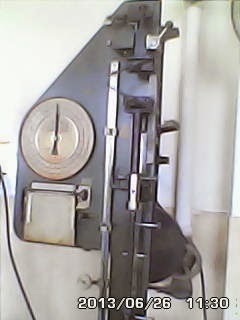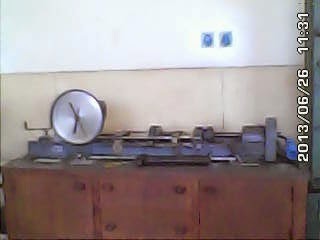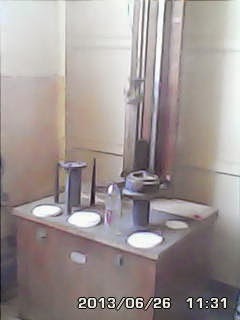Now You Know Hydroentanglement Bonding Process for Production of Nonwoven Fabric (Part-6)
Friday, 8 March 2019
Edit
Hydro-entanglement Bonding Process for Production of Nonwoven Fabric (Part-6)
Eng Mohamed Elsharkawy
Dept. of Textile Engineering
Alexandria University
Alexandria, Egypt
Email: m.elsharkawy.tex@gmail.com
Dept. of Textile Engineering
Alexandria University
Alexandria, Egypt
Email: m.elsharkawy.tex@gmail.com
4.2.2. The Hydro-entanglement unit:
It is a box made of stainless steel as it does not readily corrode, rust or stain with water as ordinary steel does, and we use two grades from stainless steel (316 & 304).
The manifold of Hydro-entanglement prototype (bases of the box) is made from 316L stainless steel (300*300*6mm) in as it is more resistant to general corrosion and pitting than conventional nickel chromium stainless steels such as 302-304. It has the following characteristics [16]:
- Higher creep resistance
- Excellent formability.
- Rupture and tensile strength at high temperatures
- Corrosion and pitting resistance
The number of water jets nozzles has been calculated according to the following equations:
Flow rate = P½ x D2 x N x 2572 x 10-8 m3/ hour/ injector/ meter
Energy = P3/2 x D2 x N x 7 x 10-10 KWH/ injector/ meter
Where:-
- P= water pressure (bar)
- D=hole diameter (mm)
- N= number of holes (per injector per meter)
 |
| Figure (4.8): shape of nozzles in plate |
IG Welding Benefits
In the space the fiber passes and subject to the water pressure which is passes vertical on the fiber causing entangling between fibers.
We but the Hydro-entanglement unit on a box to collect water in it and we return this water to the tank (source of water) by using water pump
Finally the pump had connected to the Hydro-entanglement unit and to the water tank as shown in following figure:
5.1. Introduction
In this chapter, the experiments of geo-textile fabrics; to define some important properties required, will be investigated.
Geo-textiles should fulfill certain requirements to permit material exchange between air and soil, it must allow rain water to penetrate the soil from outside and also excess water to drain out of the earth without erosion of the soil.
5.2. Experimental procedure
In this work, tests are applied to recognize the mechanical and hydraulic properties for three different samples with different weights and compare those properties for the three samples.
5.2.1. Material of geo-textile:
Geo-textiles mainly are made of poly propylene, polyester, poly(ethylene) , poly(amide), poly vinylidene chloride or fiber glass. The samples that will be tested from polyester and they are needle punched.
5.2.2. Testing procedures and apparatus
The following properties will be examined:
5.2.2.1. Fabric thickness
This test was done on fabric thickness
5.2.2.2 Fabric weight
The Samples are prepared by using a template (10*10) cm2 to cut the sample. The testing for the samples was done according to ASTM D3776.
5.2.2.3. Fabric grab tensile strength
The Samples are prepared by dimensions of (1 inch*12inch). The testing is done according to ASTM D5034. The test is done at the testing laboratory on Textile Engineering department – Faculty of engineering. The test is applied by two methods in machine direction and cross machine direction. The results reported from the average of the samples (3samples for each code) and for both directions.
5.2.2.4. Fabric tear strength (single rip by tongue)
The Samples are prepared with dimensions of (7cm*15 cm) or (3inch*12 inch). the test is done according to ASTM D2261 (standard tearing strength by single rip by tongue). The results reported from the average of the samples as 3 samples for each code.
5.2.2.5. Puncture tear strength
The samples are prepared with dimension of a circle with a diameter of (5cm). the test is done at the testing laboratory on Textile engineering department –Faculty of Engineering. The test is done as per ASTM D3786. The results reported as the average of the samples (3samples for each code).
5.2.2.6. Water permeability
The samples diameter is (25cm).the test is done as per ASTM D583. The test is done at the Testing laboratory on Textile Engineering Department –Faculty of Engineering. The results reported the average of samples (3samples for each code).
5.2.2.7. Apparent opening size (equivalent opening size)
The test is done as per ASTM D4751and done at the testing laboratory on Textile Engineering Department –Faculty of Engineering. A geo-textile specimen is placed in a sieve frame, and sand beads are placed on the sample surface. ss tester at the testing laboratory on Textile department –faculty of engineering. The testing of the samples was done as per ASTM D1777 (standard test method for fabric thickness) At measuring range (0-10 mm) and the results reported is the average of applied number of samples.
- Superior quality welds
- Welds can be made with or without filler metal
- Precise control of welding variables (heat)
- Free of spate
- Low distortion
In the space the fiber passes and subject to the water pressure which is passes vertical on the fiber causing entangling between fibers.
 |
| Figure (4.9): nozzle box |
 |
| Figure (4.10): nozzle box |
 |
| Figure (4.11): Water collecting tank |
 |
| Figure (4.12): Water cycle in proto type |
 |
| Figure (4.13): Machine prototype |
CHAPTER (5)
EXPERIMENTAL WORK
EXPERIMENTAL WORK
5.1. Introduction
In this chapter, the experiments of geo-textile fabrics; to define some important properties required, will be investigated.
Geo-textiles should fulfill certain requirements to permit material exchange between air and soil, it must allow rain water to penetrate the soil from outside and also excess water to drain out of the earth without erosion of the soil.
5.2. Experimental procedure
In this work, tests are applied to recognize the mechanical and hydraulic properties for three different samples with different weights and compare those properties for the three samples.
5.2.1. Material of geo-textile:
Geo-textiles mainly are made of poly propylene, polyester, poly(ethylene) , poly(amide), poly vinylidene chloride or fiber glass. The samples that will be tested from polyester and they are needle punched.
5.2.2. Testing procedures and apparatus
The following properties will be examined:
5.2.2.1. Fabric thickness
This test was done on fabric thickness
 |
| Figure (5.1): Thickness tester |
The Samples are prepared by using a template (10*10) cm2 to cut the sample. The testing for the samples was done according to ASTM D3776.
- The test has been done at the testing laboratory on Textile Engineering department – Faculty of Engineering.
- The fabric weight per unit area is on the scale measured in grams per Square meter.
- The results reported for the average of the samples.
 |
| Figure (5.2): precision weight balance test |
The Samples are prepared by dimensions of (1 inch*12inch). The testing is done according to ASTM D5034. The test is done at the testing laboratory on Textile Engineering department – Faculty of engineering. The test is applied by two methods in machine direction and cross machine direction. The results reported from the average of the samples (3samples for each code) and for both directions.
5.2.2.4. Fabric tear strength (single rip by tongue)
The Samples are prepared with dimensions of (7cm*15 cm) or (3inch*12 inch). the test is done according to ASTM D2261 (standard tearing strength by single rip by tongue). The results reported from the average of the samples as 3 samples for each code.
 |
| Figure (5.3): Fabrics tear strength |
The samples are prepared with dimension of a circle with a diameter of (5cm). the test is done at the testing laboratory on Textile engineering department –Faculty of Engineering. The test is done as per ASTM D3786. The results reported as the average of the samples (3samples for each code).
 |
| Figure (5.4): Puncture strength |
The samples diameter is (25cm).the test is done as per ASTM D583. The test is done at the Testing laboratory on Textile Engineering Department –Faculty of Engineering. The results reported the average of samples (3samples for each code).
 |
| Figure (5.5): Water permeability |
The test is done as per ASTM D4751and done at the testing laboratory on Textile Engineering Department –Faculty of Engineering. A geo-textile specimen is placed in a sieve frame, and sand beads are placed on the sample surface. ss tester at the testing laboratory on Textile department –faculty of engineering. The testing of the samples was done as per ASTM D1777 (standard test method for fabric thickness) At measuring range (0-10 mm) and the results reported is the average of applied number of samples.